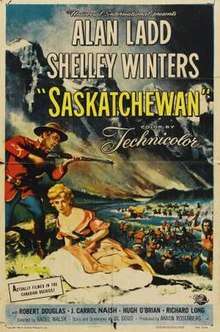Saskatchewan (film)
Saskatchewan (titled O'Rourke of the Royal Mounted in the UK) is a 1954 American Technicolor Northern/Western film directed by Raoul Walsh starring Alan Ladd and Shelley Winters. The title refers to Fort Saskatchewan in modern Alberta. Shooting was in Banff National Park, Alberta, Canada, not far from the headwaters of the Saskatchewan River.
| Saskatchewan | |
|---|---|
 | |
| Directed by | Raoul Walsh |
| Produced by | Aaron Rosenberg |
| Written by | Gil Doud |
| Based on | story by Gil Doud |
| Starring | Alan Ladd Shelley Winters |
| Cinematography | John F. Seitz |
| Edited by | Frank Gross |
Production company | Universal Pictures |
| Distributed by | Universal Pictures |
Release date |
|
Running time | 87 minutes |
| Country | United States |
| Language | English |
| Box office | $2.25 million (US)[1] 1,667,136 admissions (France)[2] |
Plot
North-West Mounted Police Sub-Inspector O'Rourke and his Cree adopted brother Cajou are returning from a trapping trip in northern Canada when they encounter a burned wagon train and sole survivor Grace. Despite the advice of the Métis scout Batouche the naive new Mountie commander Inspector Benton (recently arrived from England) believes it to be a Cree attack, however the Sioux from across the border are trying to force the Cree into being allies in their struggle with the U.S. 7th Cavalry.
O'Rourke goes against his commanding officer who have offended the Cree by disarming them; O'Rourke losing his friendship with Cajou when he personally has to take his rifle away. He later mutinies to save the Mounties who have to leave their Fort Saskatchewan for a rendezvous with a larger command at Fort Walsh. He must also aid Grace (with whom he falls in love), but she is not as helpless as she first seems as an American lawman (Hugh O'Brian) has papers for her extradition for murder.
Cast
- Alan Ladd as Thomas O'Rourke
- Shelley Winters as Grace Markey
- J. Carrol Naish as Batouche
- Hugh O'Brian as Carl Smith
- Robert Douglas as Benton
- George J. Lewis as Lawson
- Richard Long as Patrick J. Scanlon
- Jay Silverheels as Cajou
- Anton Moreno as Chief Dark Cloud
- Frank Chase as Keller
- Lowell Gilmore as Banks
- Anthony Caruso as Spotted Eagle
- Henry Wills as Merrill
- Bob Herron as Brill
Production
The film was based on an original story by Gil Doud. Universal announced it in 1952 with Glenn Ford the first star mentioned.[3]
It was Alan Ladd's second starring vehicle for Universal, for whom he had made Desert Legion. The arrangement was made in England, where Ladd was shooting Hell Below Zero.[4] The film was to be shot on location in Canada, enabling Ladd to get a tax exemption from the US government.[5][6]
"I see absolutely no reason why I should not avail myself of the exemption because it is a law," said Ladd.[7]
Shelley Winters was his co-star in June. She contracted an eye infection when she arrived on location at Lake Louise but was able to make the film.[8] Filming started August 1953.[9]
See also
References
- 'The Top Box-Office Hits of 1954', Variety Weekly, January 5, 1955.
- Box office results of Raoul Walsh films in France at Box Office Story
- "Royal Mounted Story Looks Good for Ford; Paris New Gardner Lure" Schallert, Edwin. Los Angeles Times (26 Dec 1952: B5
- "LANZA AND METRO REPORTED IN TUNE: Singer Expected to Return to Studio Fold After 7-Month Controversy, Official Says" by THOMAS M. PRYOR New York Times 4 Mar 1953: 24
- "Looking at Hollywood: Alan Ladd Set for Role of a Canadian Mountie" Hopper, Hedda. Chicago Daily Tribune 4 Mar 1953: a2.
- "Steve Cochran Plans Directing Career; 'Space Station' Put on Roster" Schallert, Edwin. Los Angeles Times 22 May 1953: B9.
- "Ladd Defends Actors' Tax Exemption Abroad; Bard Intrigues Greene" Schallert, Edwin. Los Angeles Times 3 June 1953: 21.
- "FILMING SPEEDED AT MAJOR STUDIOS: 44 Features Will Be Made in Hollywood This Month, a Big Rise Over Spring" by THOMAS M. PRYOR Special to THE NEW YORK TIMES.. New York Times 8 Aug 1953: 14.
- "STEINER TO LEAVE POST AT WARNERS: Three-Time Academy Award Winner for Musical Scores Plans Publishing Business" Special to THE NEW YORK TIMES.. New York Times 15 July 1953: 22.